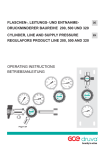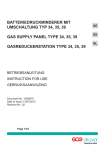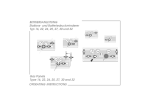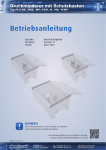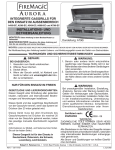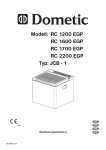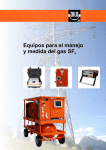Download Betriebsanleitung FMD 300
Transcript
BETRIEBSANLEITUNG Flaschendruckminderer Baureihe 300 FMD 302-14 FMD 300-18 FMD 302-18 FMD 300-14 Cylinder Pressure Regulator Series 300 OPERATING INSTRUCTIONS 1.1 Vorbemerkung Diese Armaturen sind Präzisionsinstrumente von höchster Qualität. Durch die Verwendung ausgewählter Materialien, durch hohe Oberflächengüte und Dichtheit lassen sich Druck und Durchfluß auch von reinsten Gasen ohne Verfälschung der Reinheit präzise mit gleichbleibender Genauigkeit regeln. Alle Schritte - von der Konzeption über die Fertigung bis zur Endkontrolle unterliegen den strengen Kriterien unserer Qualitätssicherung. 1.2 Bestimmungsgemäße Verwendung Die Flaschendruckminderer der Baureihe 300 zeichnen sich durch hohe Betriebssicherheit, ausgereifte Technik und vielfältige Einsatzmöglichkeiten aus. Ausschließlich in Messing gefertigt eignen sich diese Armaturen für inerte, brennbare und brennfördernde Gase und Gasgemische bis Reinheitsklasse 5.0. Sie sind für den direkten Anschluß an Gasflaschen zur Reduzierung des Flaschendruckes von maximal 200 bar auf niedrigere Ausgangsdruckbereiche vorgesehen. Die zweistufige Ausführung FMD 302 sichert konstanten Hinterdruck unabhängig von der Änderung des Vordruckes. Der zulässige Temperatureinsatzbereich reicht von -20°C bis +70°C. Beachten Sie für eine bestimmungsgemäße Verwendung neben der Bedienungsanleitung das Typenschild, das Gasartschild sowie die zugehörigen Datenblätter. 1.3 Gewährleistung und Haftung Grundsätzlich gelten unsere ”Allgemeinen Verkaufs- und Lieferbedingungen”. Gewährleistungs- und Haftungsansprüche bei Personen- und Sachschäden sind ausgeschlossen, wenn sie auf eine oder mehrere der folgenden Ursachen zurückzuführen sind: - Nicht bestimmungsgemäße Verwendung des Druckgerätes. - Unsachgemäßes Montieren, Inbetriebnehmen, Bedienen und Warten des Druckgerätes. - Betreiben des Druckgerätes bei defekten Sicherheitseinrichtungen oder nicht ordnungsgemäß angebrachten oder nicht funktionsfähigen Sicherheits- und Schutzvorrichtungen. - Nichtbeachten der Hinweise in der Bedienungsanleitung bezüglich Transport, Lagerung, Montage, Inbetriebnahme, Betrieb, Wartung und Rüsten des Druckgerätes. - Eigenmächtige bauliche Veränderungen an dem Druckgerät. - Mangelhafte Überwachung von Ausrüstungs-, Verschraubungs- und Dichtungsteilen, die einem Verschleiß unterliegen. - Unsachgemäß durchgeführte Reparaturen. - Katastrophenfälle durch Fremdkörpereinwirkung und höhere Gewalt. Personen. Nichtbeachten dieser Hinweise hat schwere gesundheitsschädliche Auswirkungen zur Folge, bis hin zu lebensgefährlichen Verletzungen. Dieses Symbol bedeutet eine möglicherweise drohende Gefahr für das Leben und die Gesundheit von Personen. Nichtbeachten dieser Hinweise kann schwere gesundheitsschädliche Auswirkungen zur Folge haben, bis hin zu lebensgefährlichen Verletzungen. Dieses Symbol bedeutet eine möglicherweise gefährliche Situation. Das Nichtbeachten dieser Hinweise kann leichte Verletzungen zur Folge haben oder zu Sachbeschädigungen führen. Dieses Symbol gibt wichtige Hinweise für den sachgerechten Umgang mit dem Druckgerät. Das Nichtbeachten dieser Hinweise kann zu Störungen am Druckgerät oder in der Umgebung führen. Unter diesem Symbol erhalten Sie AnwendungsTips und besonders nützliche Informationen. Sie helfen Ihnen, alle Funktionen an Ihrem Druckgerät optimal zu nutzen. 1.4 Urheberrecht Das Urheberrecht an dieser Bedienungsanleitung verbleibt beim Hersteller. Diese Bedienungsanleitung ist nur für den Betreiber und dessen Personal bestimmt. 2. GRUNDLEGENDE SICHERHEITSHINWEISE 2.1 Erläuterung der Hinweissymbole In der Bedienungsanleitung werden folgende Benennungen und Zeichen für Gefährdungen verwendet: Dieses Symbol bedeutet eine unmittelbar drohende Gefahr für das Leben und die Gesundheit von -1- 2.2 Besondere Sicherheitshinweise Durch den Umgang mit komprimierten Gasen und den dazugehörigen Armaturen können Gefahren für Leib und Leben des Benutzers oder Dritter bzw. Beeinträchtigungen am Druckgerät oder an anderen Sachwerten entstehen. Vor jeder Inbetriebnahme des Druckgerätes müssen alle Sicherheitseinrichtungen sachgerecht angebracht und funktionsfähig sein. Betriebsanleitung FMD 300 1. GRUNDLEGENDE HINWEISE Betriebsanleitung FMD 300 Schutzvorrichtungen und Sicherheitseinrichtungen dürfen nur entfernt werden nach Außerbetriebsetzen des Druckgerätes bzw. der Anlage und nach Absicherung gegen Wiederinbetriebnahme des Druckgerätes. Bei geöffneten Sicherheitseinrichtungen oder Störfällen können schädliche Gase und Dämpfe entweichen . Persönliche Schutzeinrichtungen sind vom Betreiber beizustellen. Bei Sauerstoffmangel oder zu hoher Schadstoffkonzentration sind von der Umgebungsatmosphäre unabhängige Atemschutzgeräte erforderlich! (VBG 1). Falls die Ventile nach Arbeitsende nicht verschlossen werden, ist ein Gasaustritt durch die Schläuche oder die angeschlossenen Verbraucher möglich! Das Schließen des Druckminderers alleine garantiert keine absolute Dichtheit. Die Bedienungsanleitung ist ständig am Einsatzort des Druckgerätes aufzubewahren. Die Bedienungsanleitung ist zu beachten. Sie enthält wichtige Hinweise, um das Druckgerät sicherheitsgerecht zu betreiben. Der Betreiber verpflichtet sich nur Personen am Druckgerät arbeiten zu lassen, die mit den grundlegenden Vorschriften über Arbeitssicherheit und Unfallverhütung vertraut sind, die in die Handhabung des Druckgerätes eingewiesen sind und das Sicherheitskapitel und die Warnhinweise in dieser Bedienungsanleitung gelesen und verstanden haben. Das Personal muß sich vor Inbetriebnahme der Armatur mit den Gefahrenhinweisen für das verwendete Gas vertraut machen. Die Zuständigkeiten des Personals sind klar festzulegen für das Montieren, Inbetriebnehmen, Bedienen, Rüsten, Warten und Instandsetzen. Anzulernendes Personal darf nur unter Aufsicht einer erfahrenen Person am Druckgerät arbeiten. Ergänzend zur Bedienungsanleitung sind die allgemeingültigen sowie die örtlichen Regelungen zur Unfallverhütung und zum Umweltschutz bereitzustellen und zu beachten. Das Druckgerät ist nur in sicherheitstechnisch einwandfreiem Zustand zu benutzen. Das Druckgerät ist nur für die bestimmungsgemäße Verwendung (siehe Typenschild, Gasartschild und Datenblatt) zu benutzen. Die zugehörigen Datenblätter sind hinsichtlich der Betriebsbedingungen beachten. Alle Sicherheits- und Gefahrenhinweise am Druckgerät sind in lesbarem Zustand zu halten. Alle mit Sauerstoff in Berührung kom-2- menden Teile müssen absolut öl- und fettfrei sein, Brand- und Explosionsgefahr! Nur Schmierstoffe mit Sauerstoffzulassung verwenden! Das Wechseln der Flaschenanschlußteile oder die Verwendung von Übergangsstücken für unterschiedliche Anschlüsse nach DIN 477 ist untersagt (Geräteschutzgesetz)! Verwendete, zur Reparatur anstehende Gasgeräte mit einem inerten Gas (Stickstoff, Argon) spülen und feste Gasrückstände sachgerecht handhaben und entsorgen, insbesondere nicht durch Schmierstoffe bzw. ölige Lappen die Verschraubungsteile verunreinigen und nicht mit Lösungsmitteln reinigen. Vorgeschriebene Einstell-, Wartungsund Inspektionsarbeiten fristgemäß durchführen lassen. 2.3 Gesetze, Normen, Vorschriften und Hinweise Gesetze und Verordnungen “Gerätesicherheitsgesetz GSG” mit "aVV allgemeinen Verwaltungsvorschriften“, 6. GSGV Druckbehälterverordnung” und “7. GSGV Gasverbrauchseinrichtungsverordnung”, ”ChemG Chemikaliengesetz” mit “GefstoffV Gefahrenstoffverordnung” und “ArbstoffV-Arbeitstoffverordnung”. Alle Teile müssen sauber verpackt, staubfrei, trocken und gut verschlossen gelagert werden. Nur sachgerechte Verpackung benützen. Technische Regeln, Unfallverhütungsvorschriften: “Technische Regeln Druckbehälter TRB” mit TRB 610, 700, 801/26, 801/27. “Technische Regeln Druckgase TRG” mit TRG 100, 101, 102, 250, 280. “Unfallverhütungsvorschriften VBG” mit VBG 1, 15, 61 und 62. “Berufsgenossenschaftliche Richtlinien ZH 1” mit ZH 1/8, 1/8.1, 1/8.2, 1/8.3, 1/10, 1/16, 1 / 119, 1/134, 1/180, 1/288, 1/307, 1/382, 1/384, 1/605. DIN-, ISO-, CEN-Normen und VDE-Richtlinien: DIN 8545 (Hauptstellendruckminderer), DIN 2403 (Kennzeichnung für Rohrleitungen nach dem Durchflußstoff). ISO 2503 (Pressure Regulators for gas cylinders used in welding, cutting and allied processes). EN 585 (Druckminderer für Gasflaschen, Schweißen, Schneiden und Verwandte Verfahren), EN 562 (Manometer für Schweißen, Schneiden und verwandte Verfahren). VDE 0170 (Errichten elektrischer Anlagen in explosionsgefährdeten Bereichen). Informationsschriften: Datenblätter Baureihe 300. 4. DATEN DER ARMATUREN 4.1 Druckminderer und Ventile FMD 300/302-14: Ein-/zweistufiger Flaschendruckminderer mit Vorund Hinterdruckmanometer, Abblaseventil und Klemmringverschraubung. FMD 300/302-18: Ein-/zweistufiger Flaschendruckminderer mit Vorund Hinterdruckmanometer, Abblaseventil und Dosierventil SVR 300 und Ausgangsverschraubung. Flaschenanschluß (je nach gewünschter Gasart) und Flammensperre (optional) sind beigefügt. Dosierventil SVR 300: Stopfbuchsventil aus Messing vernickelt und verchromt in Winkelform. Nenndruck 40 bar. 4.2 Zubehör Für die Baureihe 300 sind Verschraubungen, Schlauchtüllen und Flammensperren lieferbar. Bitte wenden Sie sich diesbezüglich an den Hersteller. Montage- und Einbauvorschriften für diese Komponenten sind unbedingt zu befolgen. Achten Sie unbedingt auf die Verwendung einwandfreier Dichtungen, auf einwandfreien Zustand aller Gewinde, auf Dichtheit und einwandfreie Funktion im fertigmontierten Zustand. Bitte beachten Sie auch Punkt 5. und 6. dieser Bedienungsanleitung. 4.3 Kennzeichnung Die Typenschilder der Druckminderer weisen folgende Kennzeichnungen aus: -3- Typenschild 1. Typkennzeichnung (... FMD 300-14). 2. Werkstoffe des Druckminderergehäuses und der Sitzdichtung des Druckminderers und ggf. des Ventils (Ms/PVDF/PCTFE). 3. Zugelassener Vordruck für dieses Gerät (Pein: ... 200 bar). 4. Gerätespezifischer Hinterdruckbereich (Paus: ... 1 6 bar). Auf dem Flaschenanschluß befindet sich ein Schild mit dem Hinweis für welche Gasart der Druckminderer geeignet ist und eine eingeschlagene Ziffer, die die Anschlußnummer festlegt (siehe Tabelle “Gasflaschenventile” weiter unten). 5. MONTAGE, ANSCHLIESSEN UND ERSTE INBETRIEBNAHME 5.1 Montage Kontrollieren Sie zuerst an Hand des Typenschildes und des Gasartschildes auf dem Flaschenanschluß, ob der Druckminderer für den vorgesehenen Verwendungszweck geeignet ist (Gasart, Druck). Verwenden Sie ausschließlich Flaschenanschlüsse des Herstellers. Vor dem Anschließen an die Gasflasche sind zuerst der Flaschenanschluß und die Flammensperre (nur Option) am Druckminderer zu befestigen. Betriebsanleitung FMD 300 3. LAGERUNG, TRANSPORT “BImSchG Immissionsschutzgesetz” mit “BImSchV FCKW-Halon-Verbotsordnung” und “2. BImSchV Emissionsbegrenzung von leichtflüchtigen Kohlenwasserstoffen”. Hersteller “AcetV Acetylenverordnung”. Betriebsanleitung FMD 300 5.1.1 Montage des Flaschenanschlusses Keinesfalls darf der Druckminderer durch Austausch des Flaschenanschlusses für eine andere Gasart eingesetzt werden. Gefahr von chemischen Reaktionen! Achten Sie darauf, daß die Gewinde am Druckminderer und am Flaschenanschluß in einwandfreiem Zustand sind. Achten Sie auf einwandfreien Zustand und Sitz des O-Ringes (4) in der Nut des Flaschenanschlusses (3). Benützen Sie nur Original-Ersatzdichtungen des Herstellers. 1. Fügen Sie den Flaschenanschluß (1) in die vorgesehene Bohrung an der Rückseite des Druckminderers (5) und drehen Sie ihn mit der Hand fest. 5.1.2 Montage der Flammensperre (lieferbares Zubehör) am FMD 300/302-14/18: Verwenden Sie aus Sicherheitsgründen ausschließlich Originalteile des Herstellers. Achten Sie sowohl auf einwandfreien Zustand von Dichtungen und Gewinden als auch auf einwandfreien Sitz aller Teile. Verwenden Sie bei der Montage neue Dichtungen. Die Dichtungen dürfen nicht deformiert sein und keine Spuren von Schmutz oder Metallspänen aufweisen. 1. Herausschrauben der am Druckminderer vorhandenen Standard-Klemmringringverschraubung (4) mit Gabelschlüssel (SW 19). 2. Einschrauben der Flammensperre (2) zusammen mit der Dichtung (1) in das Innengewinde G 1/4" am Druckmindererausgang von Hand. Festziehen mit einem Gabelschlüssel (SW 22) um 3/8 bis 1/2 Umdrehung. Dichtring (3) Montage Flaschenanschluss / FMD 300/302 Flammensperre (2) Dichtring (1) 2. Nehmen Sie einen Gabelschlüssel (SW 14) und ziehen Sie den Flaschenanschluß (1) an der Schlüsselfläche (2) des Verbindungsrohrstückes fest. Für eine feste Montage genügt das Gegenhalten mit der Hand. Klemmringverschraubung (4) Montage der Flammensperre 3. Dichtung (3) in das Innengewinde der Flammensperre (2) einlegen. Adapter (4) zunächst von Hand einschrauben und dann mit einem Gabelschlüssel (SW 19) um 3/8 bis 1/2 Umdrehung festziehen. -4- 5.2 Anschließen des Druckminderers an die Flasche. Stellen Sie sicher, daß die Gasartbezeichnung auf dem Gasartschild des Flaschenanschlusses mit der Gasart auf der Gasflasche übereinstimmt. Siehe auch die Tabelle weiter unten “Gasflaschenventile” mit Gasarteignung, Anschlußnummer und zugehörigem Gewinde. Das Gewinde am Flaschenventil und an der Überwurfmutter müssen in einwandfreiem Zustand sein. Verwenden Sie bei jeder Montage einwandfreie Dichtungen: ohne Spuren von Schmutz oder Metallspänen und ohne Beschädigungen. 1. Die Überwurfmutter auf den Ventilanschluß auf der Flasche aufschrauben. Auf Rechts- und Linksgewinde achten! Den Druckminderer ausrichten. Beim Ansetzen nicht verkanten. 2. Aufschrauben und von Hand festziehen. Keine Werkzeuge wie Zangen verwenden. Das Festziehen der gerändelten Mutter mit der Hand genügt, um ausreichende Dichtheit zu erreichen. Tabelle: Gasflaschenventile nach DIN 477. Anschluß Nr. 1, Seitenstutzengewinde W 21,80 x 1/14” links: für brennbare (leicht entzündliche) Gase und Gasgemische nach Tabelle 2 und 3. Anschluß Nr. 2, Seitenstutzengewinde W 21,80 X 1/14”: für unbrennbare oder schwer entzündliche Gase nach Tabelle 3. Anschluß Nr. 9, Seitenstutzengewinde R 3/4”: für Sauerstoff und synthetische Luft. Anschluß Nr. 10, Seitenstutzengewinde 5.3 Anschließen der Verbraucher Verwenden Sie aus Sicherheitsgründen ausschließlich Originalteile des Herstellers. Achten Sie auf einwandfreien Zustand und Sitz der Gewinde. Standard-Klemmringverschraubung. Anschließen des Rohres (2) zum Verbraucher wie unter Punkt 5.31 beschrieben. Montage von Einsteck-Schlauchtüllen 1. Montage des Adapters Einführen des Schlauchtüllen-Einsteck-Adapters (1) in die am Druckminderer vorhandene StandardKlemmringverschraubung. Dann die Überwurfmutter mit einem Gabelschlüssel (SW 12) festziehen bis die Mutter das Anschlußgewinde überdeckt und Gegenhalten mit einem Gabelschlüssel (SW 19) an der Schlüsselfläche der Standard-Klemmringverschraubung. Anschließen des Rohres (2) zum Verbraucher wie unter Punkt 5.31 beschrieben. schieben und anschließend auf den Adapter (1) schieben. Schlauchbinder (2) festziehen, um Schlauch (3) gegen Abziehen zu sichern. Bei Helium und Wasserstoff empfiehlt sich die Verwendung von Schläuchen mit besonders kleinen Diffusionsleckraten (bei Fragen wenden Sie sich bitte an den Hersteller). Alle Verbindungen müssen nach Montage mit einem Prüfspray auf Dichtheit geprüft werden. Verwenden Sie nur ein Prüfspray mit DVGW- Zulassung (DVGW = Dt. Fachverband für Gas und Wasser). Beachten Sie die Bedienungsanleitung des Prüfsprays. 5.3.1 Anschließen von 6 mm-Rohrleitungen. Einführen der Rohrleitung in die Klemmringverschraubung. Festziehen der Überwurfmutter mit 1 1/4 Umdrehungen und Gegenhalten an der Schlüsselfläche des Adapters. Auf einwandfreie Dichtheit achten. 5.3.2 Montage von Einsteck-ReduzierVerschraubungen oder Einstecktüllen Für den Anschluß von Verbrauchern an den Druckminderer stehen (neben der mitgelieferten 6mm-Klemmringverschraubung) zahlreiche weitere Klemmringverschraubungen und Schlauchtüllen als Einstecker zur Verfügung. 5.4 Rohr (3) Rohrstutzen (1) Standardklemmringverschraubung (2) Reduzieradapter Montage eines Reduzieradapters 2. Schlauchmontage Handelsüblichen Schlauchbinder (2) (nicht im Lieferumfang der Schlauchtülle) über das Schlauchende (3) Montage von Klemmring-Einsteckern Einführen des Stutzens des Klemmring-EinsteckAdapters (1) in die am Druckminderer vorhandene Standard-Klemmringverschraubung. Dann die Überwurfmutter mit einem Gabelschlüssel (SW 12) festziehen bis die Mutter das Anschlußgewinde überdeckt und Gegenhalten mit einem Gabelschlüssel (SW 19) an der Schlüsselfläche der Schlauchtülle(1) Schlauch (3) Montage von Schlauchbindern -5- Schlauchbinder (2) Inbetriebnahme 5.4.1 Vorbereitung Handrad des Druckminderers bis zum Anschlag nach links drehen - Durchgang ist damit geschlossen. Alle Ventile schließen. Vor Einschalten des Druckgerätes ist sicherzustellen, daß niemand durch das Inbetriebnehmen des Druckgerätes gefährdet werden kann. 5.4.2 Gasentnahme Stellen Sie sich neben die Armatur (nicht in Front zu den Bedienelementen) und öffnen Sie langsam das Flaschenventil. Vordruckmanometer beachten. Gewünschten Ausgangsdruck mit dem Druckmindererhandrad - durch langsame Rechtsdrehung - einstellen. Gewünschte Durchflußmenge am Dosierventil bzw. am Ventil des nachgeschalteten Gasverbrauchers einstellen. Betriebsanleitung FMD 300 W 24,32 x 1/14”: für Stickstoff. Anschluß Nr. 11, Seitenstutzengewinde R 3/8”: für Distickstoffoxid (Stickoxydul, Lachgas). Anschluß Nr. 14, Seitenstutzengewinde M 19x1,5: für nichtkorrosive Prüfgase. Bei Verwendung anderer Flaschenventile wenden Sie sich bitte an den Hersteller. Betriebsanleitung FMD 300 6. BETRIEB, FLASCHENWECHSEL UND AUSSERBETRIEBNAHME 7. WARTUNG UND INSTANDHALTUNG 8. HERSTELLER / DRUCKLEGUNG 7.1 Wartung Technische Änderungen, die dem Fortschritt dienen, sind vorbehalten. © beim Hersteller, siehe Rückseite. Printed in Germany. Gedruckt auf chlorfrei gebleichtem Papier / bd. Ausgabe 2/08/00, ba300ges. 6.1 Betrieb Alle mit Sauerstoff in Berührung kommenden Teile müssen absolut öl- und fettfrei sein. Während des Betriebes erfolgt die Änderung des gewünschten Hinterdruckes durch Drehung des Handrades im Uhrzeigersinn (Vergrößerung) oder gegen den Uhrzeigersinn (Verringerung des Ausgangsdruckes). 6.2 Wechseln der Flaschenanschlußteile oder die Verwendung von Übergangsstücken für unterschiedliche Anschlüsse nach DIN 477 ist untersagt. Flaschenwechsel 1. Absperrventil an der Gasflasche (am Druckgasbehälter) fest schließen. 2. Druckregler und Leitungen durch Ableiten des Gases über den Verbraucher entspannen. Zeiger von Vor- und Hinterdruckmanometer müssen vollständig auf “0” zurückgegangen sein. 3. Überwurfmutter an der Gasflasche lösen. 4. Neue Flasche wie oben beschrieben anschließen. 6.3 Außerbetriebnahme Bei kurzzeitiger Unterbrechung der Gasentnahme genügt das Schließen des Brauchgasausgangsventils. Bei längerer Unterbrechung muß der Druckminderer durch Drehung des Handrades entgegen dem Uhrzeiger entspannt werden. Andernfalls droht vollständiger Verlust des gesamten Gasevorrates. Aus Sicherheitsgründen bei Außerbetriebnahme das Flaschenventil schließen. Reparaturen und Wartungen sind aus Sicherheitsgründen nur vom Hersteller oder durch vom Hersteller autorisierte Fachbetriebe ausschließlich mit Originalersatzteilen des Herstellers durchzuführen. Um einwandfreie Funktion und gleichbleibende Betriebssicherheit der Armaturen sicherzustellen, sollen alle Komponenten einer Gasversorgung jährlich einmal vom Hersteller überprüft werden. Es empfiehlt sich hierfür der Abschluß eines Wartungsvertrages. Beachten Sie die Garantie- und Lieferbedingungen des Herstellers. 7.2 Betriebsstörungen Diese Druckminderer arbeiten stets zuverlässig. Sollte dennoch kein bestimmungsgemäßer Betrieb der Armatur möglich sein (z. B. unzulässiger Hinterdruckanstieg), so setzen Sie sich bitte mit dem Hersteller in Verbindung. -6- 1.1 Preliminary Remark These armatures are precision instruments of the highest quality. The use of selected materials, high surface quality and sealing allows the pressure and flow rate of even the purest gases to be regulated precisely and with constant accuracy without distorting the purity. All steps – from conception to finish to pre-delivery inspection – are subject to strict quality assurance criterias according to DIN EN ISO 9001. 1.2 Proper Use The series 300 pressure regulators for cylinders is characterized by high operational safety, advanced technology and diverse application options. These armatures, made solely of brass, are suitable for inert, combustible and combustive gases and gas mixtures up to purity class 5.0. They are designed for direct attachment to gas cylinders to reduce the cylinder pressure from maximum 200 bars to a lower outlet pressure range. The twin-stage execution of the AMD 302 guarantees constant back pressure independent of the change in the admission pressure. The permissible temperature application range extends from -20C to +70C. In addition to the operating instructions, please take note of the data plate, the gase-type plate as well as the relevant data sheets to ensure proper use. 1.3 Warranty and Liability Our ”General Sales and Delivery Conditions” are fundamentally valid. Warranty and liability claims for personal or product damage are invalid if they can be traced to one or more of the following causes: - Incorrect use of the pressure device - Incorrect assembly, start-up, operation and maintenance of the pressure device - Operation of the pressure device in cases of defective safety devices, or when safety and protection fixtures are incorrectly attached or not in proper working order. - Non-observance of the instructions in the operating manual regarding transport, storage, assembly, start-up, operation, maintenance and preparation of the pressure device. - Unauthorized structural changes to the pressure device. - Insufficient testing of equipment, connection and sealing parts that are subject to wear and tear - Repairs carried out incorrectly - Disaster situations arising from third party/ foreign body interference and Acts of God. 1.4 Copyright The copyright for these operating instructions remains with the manufacturer. These operating instructions are intended only for the operating company and its employees. 2. BASIC SAFETY INSTRUCTIONS 2.1 Explanation of Safety Symbols This symbol signifies potential danger that is life-threatening or poses a threat to the health of employees. Failure to observe these instructions can lead to serious or even lifethreatening injuries. This symbol signifies a potentially dangerous situation. Failure to observe these instructions can lead to minor injuries or property damage. This symbol points out important instructions on how to handle the pressure device correctly. Failure to observe these instructions can cause the device to malfunction or lead to disturbance in the surroundings. This symbol points out application tips and particularly useful information. It helps you optimally utilize all of the functions of your pressure device. 2.2 Special Safety Instructions Handling compressed gases and the respective armatures can result in serious injury to the user or third party or damage to the pressure device or other property. The following descriptions and characters are used in the operating instructions to illustrate danger: Before the pressure device is put into operation, all safety devices must be correctly attached and in working order. This symbol signifies immediate danger that is life-threatening or poses a threat to the health of employees. Failure to observe these instructions can lead to serious or even life-threatening injuries. Protection fixtures and safety devices may only be removed when the pressure device or the system are not operational and after safety precautions have been taken to prevent renewed operation of the pressure device. -7- Operating Instructions FMD 300 1. BASIC INSTRUCTIONS Operating Instructions FMD 300 Hazardous gases and steam can escape if the safety devices are open or malfunctions occur. The user must be provided with personal protective equipment. Respiratory equipment independent of the surrounding atmosphere is required in the event of an oxygen shortage or extremely high concentrations of harmful substances,. If the valves are not closed following completion of work, gas may escape through the hoses or the connected consumer! Closing the pressure regulators does not guarantee that no leaks will occur. employed gas. by DIN 477 (Device Protection Law). Employee responsibilities must be clearly established regarding assembly, start-up, operation, preparation, maintenance and repairs. Always flush used gas devices awaiting repairs with an inert gas (nitrogen, argon) and handle and dispose of gas residues properly. Ensure that the connecting parts are not contaminated by using lubricants or oily cloths and do not clean with solvent. Employees in training may only work with the pressure device under the supervision of an experienced person. In addition to the operating instructions, generally applicable and local regulations for accident prevention and environmental protection must be provided and observed. The pressure device may only be used if it is in perfect working condition and operationally safe. The operating instructions must always be kept in the place where the pressure device is operated. The pressure device may only be used for the intended application (see data plate, gas-type plate and data sheet). The operating instructions must be observed! They contain important instructions for the safe operation of the pressure device. The appropriate data sheets must be observed with regard to the operating conditions. The user is obligated to allow only those employees to work with the pressure device who are familiar with the fundamental work safety and accident prevention regulations, who have been instructed how to operate the pressure device, and who have read and understood the safety chapter and the safety instructions in this operating manual. Before starting up the armature, employees must familiarize themselves with the safety instructions for the All safety and danger decals on the pressure device must be kept in good, legible condition. All parts that come into contact with oxygen must be kept absolutely free of oil and grease – danger of fire and explosion. Only use lubricants that are oxygenapproved. It is prohibited to change the connecting parts of the cylinder or to use temporary parts for various connections as defined -8- Have the prescribed adjustment, maintenance and inspection work carried out within the specified time. 2.3 Laws, Standards, Regulations and Instructions Laws and Decrees: ”Device Safety Law GSG” with general administrative regulations aVV, ”Pressure Container Decree 6. GSGV” and ”Gas Consumer Facilities Decree 7. GSGV”. ”Chemicals Law ChemG” with ”Noxious Substances Decree GefstoffV” and ”Work Substances Decree ArbstoffV”. ”Acetylene Decree AcetV”. ”Law for the Protection Against the Effects of Noxious Substances BLMSchG” with ”FCKW Halon Prohibition Order BlmSchV” and ”AntiPollution Limitation On Lightly Volatile Carbon Hydrogen 2. BlmSchV”. Technical Regulations, Accident Precaution Regulations: ”Technical Regulations Pressure Container TRB” with TRB610, 700,801/26/BOT/27. ”Technical Regulations Pressure Gas TRG” with TRG 100, 101, 102, 250, 280. ”Accident Precaution Regulations VBG” with EN 585 (pressure regulators for gas cylinders used in welding, cutting and allied processes), EN 56 (pressure gauges used in welding, cutting and allied processes). VDE 0170 (constructing electrical facilities in areas where explosions may occur). Information Sheets: Data sheets for the 300 series. 3. STORAGE AND TRANSPORT All parts must be properly wrapped, sealed and stored in a dust-free, dry place. Use only proper packaging. 4. TECHNICAL DATA 4.1 Pressure Regulators and Valves FMD 300-14/18 Single-stage pressure regulator for cylinders with admission and back pressure gauges, relief valve and metering valve SVR 300 (only with FMD 300-18). FMD 302-14/18 Twin-stage pressure regulator for cylinders with admission and back pressure gauges, relief valve Cylinder connection (depending on desired type of gas) and flame arrester (optional) are included. Metering valve SVR 300: Nickel-plated and chromium-plated angular brass chevron valve. Nominal pressure 40 bars. 4.2 Accessories Connections, hose nozzles and flame arresters are available for the 300 series. Please contact the manufacturer for more information. The assembly and installation regulations for these components must be adhered to. Ensure that the seals and all threads are in perfect condition and that the assembled product is completely sealed and in good working conditions. Please take note of Items 5. and 6. of these operating instructions. 4.3 Labelling The label plates of the pressure regulator show the following: Type: FMD 300-14 Material: brass/PVDF/PCTFE Pin: 200 bars Pout: 1-6 bars Warning! Parts under pressure. Servicing by authorized personnel only He Label plate 1. Product model (...FMD 300-14). 2. Material of pressure regulator casing and the pressure regulator seat seal and, if applicable, of the valve (Ms=brass/PVDF/PCTFE). 3. Permissible admission pressure for the device (Pein: ....200 bars). 4. Back pressure values for the device -9- (Paus: 0,5 - 6 bars). 5. Date of maufacturing and a security information. A plate on the cylinder connection indicates which type of gas can be used with the pressure regulator. An imprinted number on the plate stipulates the connection number (see the table ”Gas Cylinder Valves” chapter 5.2). 5. ASSEMBLY, CONNECTION AND INITIAL START-UP 5.1 Assembling the cylinder connection and the flame arrester First check if the pressure regulator is suitable for the planned application (type of gas, pressure) according to the product label and the gas-type plate on the connection. Use only cylinder connections of the manufacturer. The cylinder connection and the flame arrester (optional) must be attached to the pressure regulator before they are connected to the gas cylinder. 5.1.1 Assembling the cylinder connection Under no circumstances may the pressure regulator be used for another type of gas by changing the cylinder connection. Danger of chemical reactions. Make sure that the threads on the pressure regulator and the cylinder connection are in perfect condition. Make sure that the O-ring (4) in the groove of the cylinder connection (3) is Operating Instructions FMD 300 ISO 2503 (pressure regulators for gas cylinders used in welding, cutting and allied processes). and metering valve SVR 300 (only with FMD 302-18). Manufacturer VBG 1, 15, 61 and 62. ”Professional/Trade Association Guidelines ZH 1” with ZH1/8, 1/8.1, 1/8.2, 1/8.3, 1/10, 1/16, 1/119, 1/134, 1/180, 1/288, 1/307, 1/382, 1/ 384, 1/605. DIN, ISO, CEN Standards and VDE Guidelines: DIN 8545 (principle pressure regulators), DIN 2403 (label for pipe lines according to the flow substance). Operating Instructions FMD 300 in proper position and in perfect condition. Use only original manufacturer replacement seals. nescessary. 2. Screw the flame arrester (2) together with the seal (1) into the back pressure female outlet G ¼" of the pressure regulator by hand. Tighten with a spanner (SW 22) by 3/8 to 1/2 of a rotation. 1. Insert the cylinder connection (1) in the corresponding bore on the reverse side of the pressure regulator (5) and tighten it with your hand. Table: Gas Cylinder Valves According to DIN 477 Seal (3) Flame arrester (2) Seal (1) Tube fitting (4) Mounting the flame arrestor Mounting the flange connection to the FMD 300/302 2. Take a spanner with nominal width 14 mm (spanner width at the joint) and tighten the flange connection. Holding the connection in place with your hand while tightening is sufficient. 5.1.2 Assembling the flame arrester For safety purposes use only original parts from the manufacturer. Make sure that the seals and threads are in perfect condition and that the parts are inserted properly. Use new seals for each assembly. The seals may not be deformed or have any traces of dirt or metal shavings. 1. Screw out the tube fitting (4) with a spanner (SW 19). Make sure that the seal (1) is in perfect conditon. Replace the seal with a new one if 1. Screw the union nut to the valve connection of the cylinder. Pay attention to the left and right threads! Align the pressure regulator. Ensure that it does not jam when attaching. 2. Screw and tighten using your hand. Do not use tools such as pliers. Tightening the knurled nut with your hand is sufficient. 3. Insert the seal (3) into the female outlet of the flame arrester (2). Screw in the tube fitting (4) at first by hand. Then tighten with a spanner (SW 19) by 3/8 to 1/2 of a rotation. 5.2 Connecting the Pressure Regulator to the Cylinder Ensure that the gas-type label on the gas-type plate of the cylinder connection matches the type of gas on the gas cylinder. See also the table below ”Gas Cylinder Valves” with gas-type characteristics, connection number and respective threads. The thread on the cylinder valve and the connection nut must be in perfect condition. Use perfect seals for each assembly. The seals may not be deformed or have any traces of dirt or metal shavings. - 10 - Connection No. 1, lateral screwneck W 21.80 x 1/ 14” left: for combustible (easily flammable) gases and gas mixtures according to table 2 & 3. Connection No. 2, lateral screw neck W 21.80 x 1/ 14”: for incombustible or inflammable gases according to table 3. Connection No. 9, lateral screw neck R 3/4”: for oxygen and synthetic air. Connection No. 10, lateral screw neck W24.32 x 1/ 14”: for nitrogen. Connection No. 11, lateral screw neck R3/8”: for dinitrogen monoxide (laughing gas). Connection No. 14, lateral screw neck M 19 x1.5: for non-corrosive testing gases. Please contact the maufacturer if you are using other cylinder valves. 5.3 Connecting the consumers For safety reasons use only parts of the manufacturer. Make sure that the threats are in perfect condition and inserted properly. 5.3.1 Mounting the 6mm-consumer pipes Insert the connecting pipe into the tube fitting. Tighten the union nut with spanner (SW 12) until the union nut completely covers the thread. Be careful to get tight connections. To connect consumers to the pressure regulators there are several additional adapters (beside the standard tube fitting 6mm) deliverable: tube fitting reducers and hose nozzle tube adapters. Assembling tube fitting reducers 5.4.2 Extracting Gas Hose nozzle (1) Hose (3) Hose clamp (2) Assembling hose nozzle tube adapters Insert the connecting tube (1) of the tube fitting adapter into the standard tube fitting of the pressure regulator. Tighten the union nut (2) with a spanner (SW 12) until the union nut completely Mounting the hose Push the hose (3) onto the hose nozzle (1) and attach with a commercially approved hose clamp (2) (available accessory). When using helium and hydrogen, we recommend that that you use hoses with particularly small diffusion rates (if you have any questions, please contact the manufacturer). Connection tube (1) Union nut (2) Tube (3) Tube fitting reducer Assembling tube fitting reducers covers the threat. To connect the tube (3) to the consumer follow the instructions in chapter 5.3.1 Using a ¼” pipe: The original adapter can be used with a ¼” pipe. Replace the cutting ring, thrust collar and the union nut. Replacement parts are available from the manufacturer. Assembling the hose nozzle tube adapter Screw the hose nozzle tube adapter (1) into the standard tube fitting of the pressure regulator. Tighten the union nut with spanner (SW 12) until the union nut completely covers the thread. All connections must be tested for tightness with a test spray following assembly. Only use a test spray that is DVGW-approved (DVGW = DI. Fachverband für Gas und Wasser - Trade Association for Gas and Water Sealing). Please take care of the test spray users manual. 5.4 Start-Up 5.4.1 Preparation Turn the hand wheel of the pressure regulator to the left to the end position – this closes the passage. Close all valves. Before switching on the pressure device, ensure that no one can be injured during the start-up process. - 11 - Place yourself beside the armature (not in front of the operating elements) and slowly open the cylinder valve. Monitor the admission pressure gauge. Regulate the desired outlet pressure with the hand wheel of the pressure regulator by slowly turning it to the right. Regulate the desired flow rate on the metering valve or if applicable on the valve of the connected consumer. 6. OPERATION, CHANGING CYLINDERS, CEASING OPERATION 6.1 Operation During operation, you can adjust the back pressure as desired by turning the hand wheel clockwise (increase) or counter-clockwise (decreasing the outlet pressure). 6.2 Changing Cylinders 1. Close the stop valve on the gas cylinder tightly (on the compressed gas container). 2. Relieve the pressure regulator and hoses by diverting the gas via the consumer. The pointers for the admission and back pressure gauges must have completely returned to ”0”. 3. Remove the union nut on the gas cylinder. 4. Connect a new cylinder as described above. 6.3 Ceasing Operation To interrupt gas extraction for brief periods it is sufficient to close the outlet valve for the operating Operating Instructions FMD 300 5.3.2 Assembling of tube fitting reducers and hose nozzle tube adapters Operating Instructions FMD 300 gas. For a longer period of interruption, the pressure regulator must be relieved by turning the hand wheel to the left. For safety reasons close the cylinder valve. 7. WARRANTY AND MAINTENANCE 7.1 Warranty All parts that come into contact with oxygen must be kept absolutely free of oil and grease. It is prohibited to change the connecting parts of the cylinder or to use temporary parts for various connections as defined by with DIN 477 (Device Protection Law). 7.2 Operating Malfunctions These pressure regulators always function reliably. If, however, it is not possible to operate the armature correctly, i.e. improper increase of the back pressure, please contact the manufacturer. 8. PRINTING INFORMATION Copyright to the manufacturer. Improvements are subject to alterations. Printed in Germany. Edition 2/ 08/00, ba300ges. Printed on chloride free bleached paper, bd. 9. SUPPLIER Please follow the information on the adhesive label mounted at the cover back page. For safety reasons, repairs and maintenance may only be carried out by the manufacturer or by a specialized company that is authorized by the manufacturer to do repairs using only original replacement parts from the manufacturer. All components of a gas system should be inspected by the manufacturer annually in order to guarantee that all armatures remain in good working order and are operationally safe. It is recommended that a maintenance contract be drawn up for this purpose. Please take note of the guarantee and delivery conditions of the manufacturer. - 12 - please insert adress of the manufacturer (see back cover) stamps. sufficient put on Please Redelivery formular - pressure device Device: . . . . . . . . . . . . . . . . . . . . . . . . . . . . . . . . . . . . . . . . . . . . . . . . . . . . . . . . . . Type / Serial number: . . . . . . . . . . . . . . . . . . . . . . . . . . . . . . . . . . . . . . . . . Kind of assembly: . . . . . . . . . . . . . . . . . . . . . . . . . . . . . . . . . . . . . . . . . . . . . Operation mode: . . . . . . . . . . . . . . . . . . . . . . . . . . . . . . . . . . . . . . . . . . . . . . . Date:. . . . . . . . . . . . . . . . . . . . . . . . . . . . . . . . . . . . . . . . . . . . . . . . . . . . . . . .. .. . . Sign: . . . . . . . . . . . . . . . . . . . . . . . . . . . . . . . . . . . . . . . . . . . . . . . . . .. .. . . . . . . . . This pressure device has been cleaned and purged with inert gas; nevertheless it can not be excluded, that there are to be found rests of these listed gases: .................................................................... .................................................................... Sender Name: Company: Street: Postcode: City: Country: Telefone: Fax: .................................................................... ........................................................ ........................................................ ........................................................ ................................. ........................................................ ........................................................ ............................ ............................ Detailed information at the following adress: Company: . . . . . . . . . . . . . . . . . . . . . . . . . . . . . . . . . . . . . . . . . . . . . . . . . ... . . . . Name: . . . . . . . . . . . . . . . . . . . . . . . . . . . . . . . . . . . . . . . . . . . . . . . . . . . . . . . . . ... Telefone: . . . . . . . . . . . . . . . . . . . . . . . . . . . . . . . . . . . . . . . . . . . . . . . . . . . . . . . . Please write in block letters! ........................................................ ........................................................ ........................................................ ........................................................ ........................................................ frankieren ausreichend Bitte Rücklieferungsschein Druckgerät Gerät / Anlagenteil: . . . . . . . . . . . . . . . . . . . . . . . . . . . . . . . . . . . . . . . . . . . Typ / Seriennummer: . . . . . . . . . . . . . . . . . . . . . . . . . . . . . . . . . . . . . . . . . . Einbauart: . . . . . . . . . . . . . . . . . . . . . . . . . . . . . . . . . . . . . . . . . . . . . . . . . . . . . . . Betrieb:. . . . . . . . . . . . . . . . . . . . . . . . . . . . . . . . . . . . . . . . . . . . . . . . . . . . . . . . . Datum:. . . . . . . . . . . . . . . . . . . . . . . . . . . . . . . . . . . . . . . . . . . . . . . . . . . . . . . . . . Unterschrift:. . . . . . . . . . . . . . . . . . . . . . . . . . . . . . . . . . . . . . . . . . . . . . . . . . . . Dieses Druckgerät / dieses Anlagenteil wurde von uns gereinigt und mit Inertgas gespült; trotzdem ist nicht auszuschließen, daß noch Reste folgender Gase vorhanden sind: .................................................................... .................................................................... .................................................................... Absender: Name: Firma: Straße: ........................................................ ........................................................ ........................................................ PLZ/Ort: Telefon: Fax: ........................................................ ........................................................ ........................................................ Nähere Auskünfte unter folgender Adresse: Firma: . . . . . . . . . . . . . . . . . . . . . . . . . . . . . . . . . . . . . . . . . . . . . . . . . . . . . . . . . . . Name:. . . . . . . . . . . . . . . . . . . . . . . . . . . . . . . . . . . . . . . . . . . . . . . . . . . . . . . . . . . Telefon:. . . . . . . . . . . . . . . . . . . . . . . . . . . . . . . . . . . . . . . . . . . . . . . . . . . . . . . . . Bitte vollständig in Druckschrift ausfüllen!
















